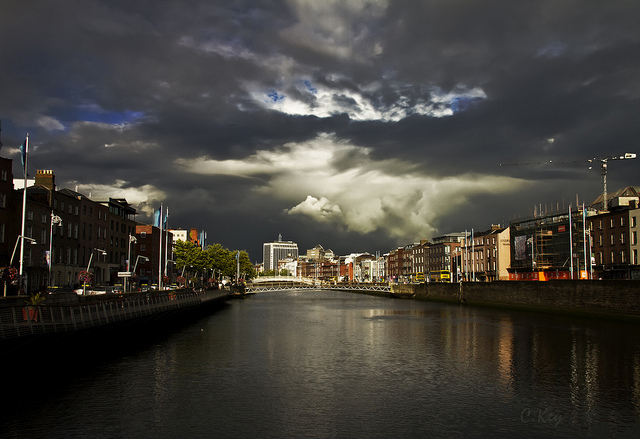Daniel Scott | Health Science Correspondent
Last night saw the launch of the Science Gallery’s latest exhibition, STRANGE WEATHER. The exhibition offers the public a thought provoking and interactive look into how life will be affected with climate change, steering away from the didactic and helpless fashion it is generally depicted in today.
“We can only manage to ignore the situation with our climate to a point. More awareness is needed so we can be able to live with the new and mitigate the change” said Gerald Fleming, Head of Met Eireann and Co-Curator of STRANGE WEATHER. Although for some countries climate change is of particular fear with extreme conditions, luckily Ireland looks like it’s in for more discreet changes. “What we’re looking at is wetter winters and drier summers, such as those seen with this year.” Severe storms are predicted to be the worst to expect but it all depends on the region, as microclimates within small regions are generally what makes the forecast unpredictable. For those of us who are real fanatics of weather, it’s likely the Weather Underground has been displaying more erratic and changing weather for quite a while, though they are only minute changes.
Some of the interactive features at STRANGE WEATHER include a green screen which gives visitors the chance to give a pre-scripted weather forecast in tune with what is expected to occur in fifty to one hundred years. “Weather Betting” puts to the test Met Eireann’s sophisticated statistical predictions which have the capacity to reach into the next 8 days for a particular day against the public, which is given by averages from individual predictions. Those entertained by Rodney and Delboys attempts to spread jinxed ashes in an Only Fools and Horses Christmas Special may be also interested in “I want to be the rain”, a more sentimental project which sends cremated remains of loved ones in a cloud seed to be eventually returned to the sea.
Although the cold weather makes it more difficult for microbes to survive, the increased amount of time spent indoors and with more people in proximity, makes it easier for an influenza virus to call you home.
With this in mind, I decided to investigate how the weather can affect our wellbeing. Although Australians may seem to have it so lucky producing vitamin D, which we lack between October and March in Ireland, it’s high UV index makes it the country with the highest incidence of skin cancers. With a diminishing ozone layer, the sun provides a perfect example of how we as humans have begun to adapt to this ever changing future. The UV index was in fact only standardised by the World Health Organisation (WHO) in 1994, two years after its creation in order to develop a comparative scale to warn and advise populations about potential health hazards . Damp or wet conditions have shown to worsen symptoms of rheumatoid arthritis and other related inflammatory conditions such as psoriasis. The old wives tale of “wrapping up” to prevent colds is something of a paradox – although the cold weather makes it more difficult for microbes to survive, the increased amount of time spent indoors and with more people in proximity, makes it easier for an influenza virus to call you home.
Considering the climate is something that is going to inevitably change and that we take for granted, it’s about time we looked at it in this light – for health, and for wealth.
On the more strange and solitary studies conducted in recent times, a British Medical Journal case report from 2012 looked at the time overlap of a patient suffering from anxiety disorder. A correlation was found between the wind blowing southeast and the patient feeling less energetic, which correlates to a higher level of anxiety due to the fatigue on the body brought on by adrenaline overdrive. Speleotherapy is a trend only reaching our waters but rampant in Central Europe, where a “microclimate” in salt caves is exploited in order to treat asthma, hay fever and other respiratory complications. The theory behind the treatment relies on nanoparticles of common salt in an aerosol-like suspension entering the lungs where it is believed to improve general function due to flushing the respiratory tract with “cleaner” air with the absence of common allergens. However, Cochrane, the leading systematic review publication for Health Care Professionals deemed inconclusive evidence for this therapy as long ago as 2001.
Other preliminary studies up to date have also hypothesised a decrease in newborn baby weight with colder summers in Sweden. An increase in hyponatremia (a potentially fatal sodium deficiency to those not TBSI based) admissions to Swiss hospitals with higher temperatures and relative humidity is thought to be caused by a lack of air conditioning in summer times tied in with a lack of staying hydrated. This finding further supports the argument that during the hot summer months, a portable AC unit will be well worth the money
Considering the climate is something that is going to inevitably change and that we take for granted, it’s about time we looked at it in this light – for health, and for wealth.







